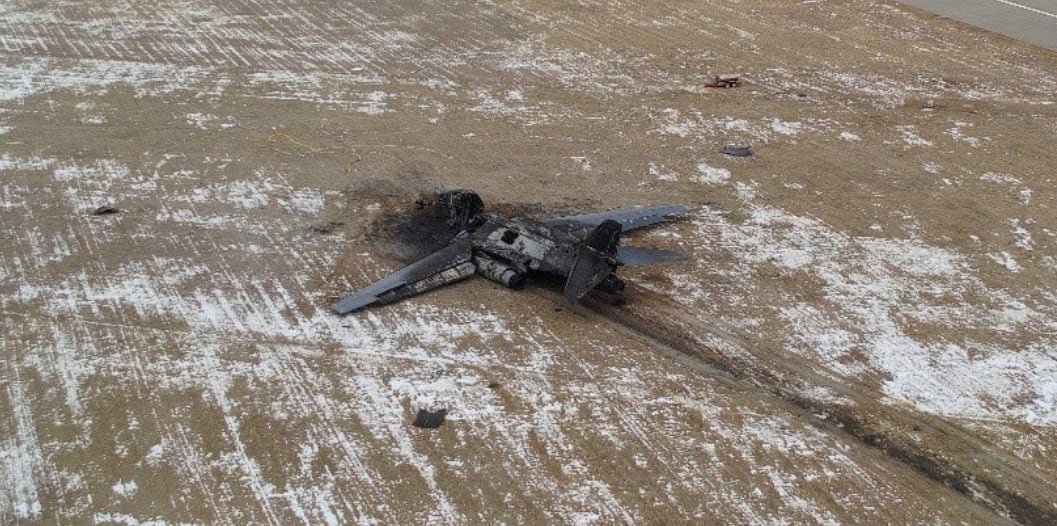The crew of a B-1B Lancer that crashed at Ellsworth Air Force Base in South Dakota in January failed to properly manage the bomber’s airspeed and angle of approach while landing, a scathing accident investigation board report found.
The investigation, which Air Force Global Strike Command released Thursday, also found that poor weather conditions, a lack of discipline, poor resource management and communication, and “an organizational culture that tolerated decaying airmanship skills” were among the other factors contributing to the Jan. 4 crash.
The report, signed by accident investigation board president Col. Erick Lord, criticized the 34th Bomb Squadron’s alleged lack of effective supervision of flying operations, and the 28th Operations Support Squadron’s alleged failure to communicate airfield and weather conditions, which “all speak to culture and leadership issues.” Investigators also said they found “unsatisfactory levels of basic airmanship” at the 34th.
“Many failures leading to this mishap were not a one-time occurrence or an aberration,” the report concluded. “The mishap occurred due to numerous factors, including a culture of noncompliance, widespread deviation from established policy and procedure, and several organizational influences and preconditions.”
Global Strike said the chain of command will take the appropriate corrective actions to address the problems highlighted in the report.
RELATED
:quality(70)/cloudfront-us-east-1.images.arcpublishing.com/archetype/7GMCLUXTWRAYVGMIDNMPLSJS6Q.jpg)
The four members of the bomber’s air crew ejected during the crash; two sustained injuries and were treated and released from a medical facility.
Fire engulfed the $451 million B-1 bomber, which was assigned to the 28th Bomb Wing at Ellsworth, and it was a total loss.
The B-1 bomber was one of two that took part in a routine training flight that began the afternoon of Jan. 4. Winds were calm when the pair of bombers took off, but during the roughly 90-minute flight, the weather worsened and dense fog began rolling across the airfield. The bombers cut their training flights short and headed back to the base.
The first bomber landed safely. But the fog left the crew of the doomed B-1 with low visibility as it approached the airfield, the report said, and the winds rapidly shifted during the flight’s final minute, speeding the bomber up. The pilot reduced the engine throttle three times to cut the bomber’s airspeed and stay on the right angle.
But when the wind stabilized, the report said the pilot didn’t dial the throttle back up to return the bomber to the right airspeed. The bomber dropped below its intended glide path and “became thrust deficient,” but the air crew didn’t realize the bomber’s vertical velocity had dropped before it became unrecoverable.
Four seconds before the crash, the instructor pilot on board called out “climb, climb, climb,” and then two seconds later repeated “climb.” The report said the data suggests that after the instructor’s final call to climb, the pilot hit the afterburners and pulled the control stick back, but by that point the bomber “was unrecoverable and out of control.”
The bomber first hit the ground about 100 feet shy of the runway overrun, and the crew compartment lost power and went dark. The crew then ejected. The bomber skidded for about 5,000 feet across the runway, veering to the left, before coming to a flaming halt in an infield between two runways.
The report found that the main cause of the crash was the crew’s lack of an effective “composite crosscheck,” a practice which brings together various instruments to keep track of how the aircraft is performing in a low-visibility environment. Had an effective crosscheck been performed, investigators found, the crew should have been able to tell the plane’s speed was dropping dangerously.
“The [mishap crew] succumbed to complacency and fixation, while the [mishap instructor pilot] was ineffective in his crew leadership and instructor supervision duties,” the report concluded.
Poor weather conditions – including icing conditions during the descent phase – and a lack of awareness of airfield conditions substantially contributed to the crash, investigators found.
The report said investigators did not find any maintenance issues contributed to the crash.
The loss of the bomber represented another blow to an already dwindling B-1 fleet, which now numbers 44.
The B-1, a conventional bomber that is not nuclear-capable, was flown extremely hard during the wars in Iraq and Afghanistan, and the fleet has suffered from serious maintenance problems as a result.
The Air Force retired 17 of the oldest and most worn-out B-1s in 2021 in an attempt to free up resources to maintain healthier planes, leaving it with 45. The service hopes to keep flying them, along with the B-2 Spirit and B-52 Stratofortress, until the B-21 Raider comes online. At some point in the 2030s, the Air Force plans to retire all its B-1s and B-2s.
Ellsworth halted B-1 operations the day after the crash and closed its runway for a month. Some Ellsworth B-1s were sent to Dyess Air Force Base in Texas during the investigation.
During that period, Ellsworth B-1s that had temporarily relocated to Dyess took part in strikes against Iran-linked targets in Iraq and Syria after drone strikes killed three U.S. troops and wounded dozens more.
Stephen Losey is the air warfare reporter for Defense News. He previously covered leadership and personnel issues at Air Force Times, and the Pentagon, special operations and air warfare at Military.com. He has traveled to the Middle East to cover U.S. Air Force operations.


